
Thomas Cowperthwait Eakins was an American realist painter, photographer, sculptor, and fine arts educator. He is widely acknowledged to be one of the most important American artists.
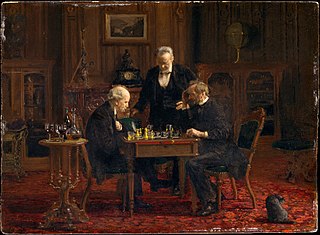
The Chess Players is an 1876 genre painting by Thomas Eakins, Goodrich catalogue #96. It is in the collection of the Metropolitan Museum of Art, in New York.

Raphael Zalman Soyer was a Russian-born American painter, draftsman, and printmaker. Soyer was referred to as an American scene painter. He is identified as a Social Realist because of his interest in men and women viewed in contemporary settings which included the streets, subways, salons and artists' studios of New York City. He also wrote several books on his life and art.
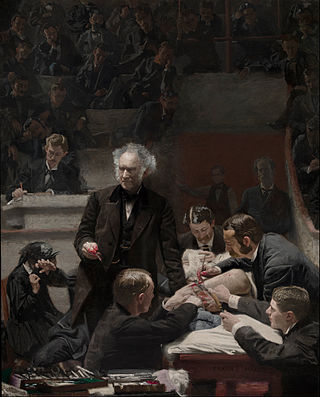
The Gross Clinic or The Clinic of Dr. Gross is an 1875 painting by American artist Thomas Eakins. It is oil on canvas and measures 8 feet (240 cm) by 6.5 feet (200 cm).

Thomas Pollock Anshutz was an American painter and teacher. Known for his portraiture and genre scenes, Anshutz was a co-founder of The Darby School. One of Thomas Eakins's most prominent students, he succeeded Eakins as director of drawing and painting classes at the Pennsylvania Academy of Fine Arts.

Max Schmitt in a Single Scull is an 1871 painting by Thomas Eakins, Goodrich catalogue #44. It is in the permanent collection of the Metropolitan Museum of Art. Set on the Schuylkill River in Philadelphia, Pennsylvania, it celebrates Eakins's friend Max Schmitt's victory in the October 5, 1870, single sculls competition.

The Concert Singer is a painting by Thomas Eakins (1844–1916), depicting the singer Weda Cook (1867–1937). The work, commenced in 1890 and completed in 1892, was Eakins's first full-length portrait of a woman. It is now in the Philadelphia Museum of Art.

The Thinker: Portrait of Louis N. Kenton is an oil painting of 1900 by the American artist Thomas Eakins. It is a depiction of the artist's brother-in-law, Louis N. Kenton (1865-1947), and it has been called "one of Eakins's most memorable portraits". The painting is one of a series of life size standing male portraits painted late in Eakins's career.
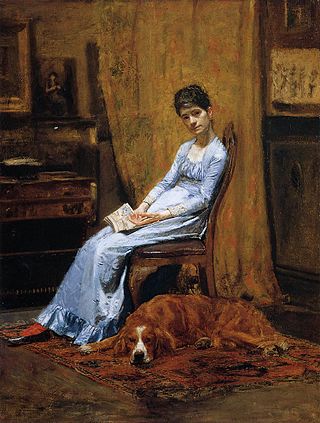
Susan Hannah Eakins was an American painter and photographer. Her works were first shown at the Pennsylvania Academy of the Fine Arts, where she was a student. She won the Mary Smith Prize there in 1879 and the Charles Toppan prize in 1882.

Wrestlers is a name shared by three closely related 1899 paintings by American artist Thomas Eakins,. The Los Angeles County Museum of Art (LACMA) owns the finished painting (G-317), and the oil sketch (G-318). The Philadelphia Museum of Art (PMA) owns a slightly smaller unfinished version (G-319). All three works depict a pair of nearly naked men engaged in a wrestling match. The setting for the finished painting is the Quaker City Barge Club (defunct), which once stood on Philadelphia's Boathouse Row.

The Fairman Rogers Four-in-Hand is an 1879-80 painting by Thomas Eakins. It shows Fairman Rogers driving a coaching party in his four-in-hand carriage through Philadelphia's Fairmount Park. It is thought to be the first painting to examine precisely, through systematic photographic analysis, how horses move.

Portrait of Mary Adeline Williams is the title given to two separate oil on canvas paintings by Thomas Eakins, each depicting Mary Adeline Williams (1853–1941), known familiarly to the Eakins family as "Addie". The first painting, now in the Art Institute of Chicago, was completed in 1899, and portrays the subject with a serious demeanor. The second portrait, in the Philadelphia Museum of Art, was painted in 1900, and is more emotionally expressive. The contrast between the paintings has been called "Perhaps the most famous example of Eakins's transforming a sitter dramatically while maintaining the effect of severe realism."

Self-portrait is an oil on canvas painting by Thomas Eakins, presented as a diploma piece upon his election as an Associate member of the National Academy of Design in 1902. Although Eakins included himself as an observer or participant in group portraits and genre scenes, this and a smaller unsigned and undated oil, thought to have been made at about the same time, are the only unadorned self-portraits he ever painted. Lloyd Goodrich wrote that it "is not only one of his finest head and bust likenesses, but a revealing human document; in the direct look of his remarkable eyes one can see strength, penetrating intelligence, and a touch of ironic humor."
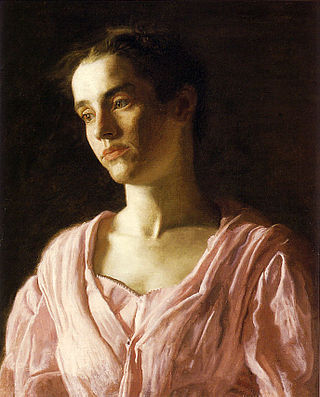
Portrait of Maud Cook is an 1895 painting by the American artist Thomas Eakins, Goodrich catalogue #279. It is in the collection of the Yale University Art Gallery.
Art Students' League of Philadelphia was a short-lived, co-operative art school formed in reaction to Thomas Eakins's February 1886 forced-resignation from the Pennsylvania Academy of the Fine Arts. Eakins taught without pay at ASL from 1886 until the school's dissolution in early 1893.

Frank Benton Ashley Linton was an American portrait-painter and teacher. He was a student of Thomas Eakins, studied the École des Beaux-Arts, and won a bronze medal at the 1927 Salon Nationale in Paris. Likely a closeted gay man, he lived with pianist Samuel Meyers for more than thirty years.
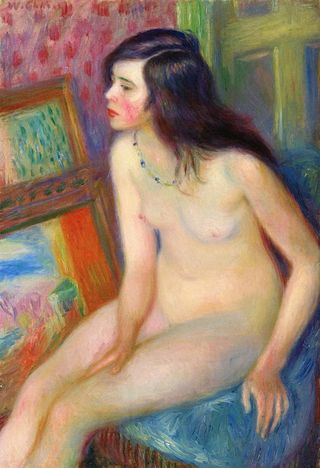
Joseph E. Temple Fund Gold Medal (defunct) was a prestigious art prize awarded by the Pennsylvania Academy of the Fine Arts most years from 1883 to 1968. A Temple Medal recognized the best oil painting by an American artist shown in PAFA's annual exhibition. Recipients included James Whistler, John Singer Sargent, Winslow Homer, Thomas Eakins, Robert Henri and Edward Hopper.

The conservation-restoration of Thomas Eakins' The Gross Clinic refers to the on-going conservation-restoration treatments of American painter Thomas Eakins' 1875 painting The Gross Clinic throughout the 20th and 21st centuries. These treatments are a testament to the changing methodologies undertaken in the field of paintings conservation.

Archbishop William Henry Elder is a 1903 oil portrait by the American artist Thomas Eakins depicting the Archbishop of Cincinnati William Henry Elder, one of a series of portraits of Catholic clergy Eakins undertook late in his career. In this psychologically probing portrait, Eakins depicts the stoic Elder, frail but still imposing at 84, confronting his own mortality.




















